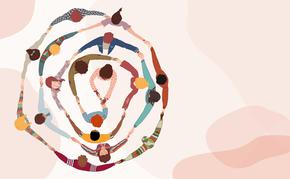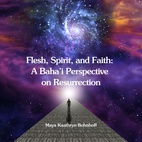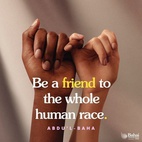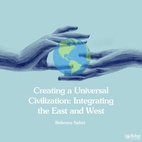The views expressed in our content reflect individual perspectives and do not represent the authoritative views of the Baha'i Faith.
Understanding culture as “a universe of shared meanings” helps clarify how individual thought and the words we use to name things become wrapped up with everything operating in that universe.
Our thoughts and the words we employ to express those thoughts are influenced by our culture’s language, customs, values, beliefs, and institutions – financial, educational, legal, familial, medical, etc.
Viewing culture this way can help sort out basic reasons for intercultural and cross-cultural conflicts. It can also help us evaluate why those conflicts occur, and ultimately get rid of our biases and prejudices. In his writings Baha’u’llah, the prophet and founder of the Baha’i Faith, frequently alluded to creation as a “kingdom of names” that we need to recognize and detach ourselves from:
… The dwellers of the kingdom of names have busied themselves with the gay livery of the world, forgetful that every man that hath eyes to perceive and ears to hear cannot but readily recognize how evanescent are its colors.
RELATED: Unity in Diversity: Is Peace on Earth the Future?
We can think of these “names” within this universe of shared meanings as the many symbols we use to organize ourselves and to communicate.
To illustrate: on Tuesday, July 27 the dollar is worth 110.36 yen and Honda is at 31.49 USD on the NYSE. The meanings of these symbols exists within a web of ideas. A monetary unit or a share price has no existence in the world of nature, but symbolizes a transaction among individuals in a specific culture and time. A date has no existence outside a cultural system of time-telling, which exists as an agreement among ourselves.
What Categorizing People Does
What we probably don’t realize is that we also view other people symbolically when we categorize them.
For instance, Christian nations had previously justified enslaving non-Christian Africans because they were considered “perpetual enemies” of Christianity. But when the enslavers Christianized their human property, their workers of African origin could no longer be considered enemies of Christendom and thus shouldn’t be enslaved. The immediate result: the practice of Christianizing was abandoned, which enabled the enslavers to continue victimizing people of African descent.
It may surprise you to know that the first Africans who arrived in Jamestown, Virginia in the early seventeenth century were considered laborers, not enslaved people. They participated as equals in the community in all regards, including intermarriage. Some eventually became planters. It wasn’t until the end of the 17th century that a series of laws were passed which became the basis for restricting the rights of Africans and their descendants and hardening the institution of slavery. Meanwhile, planters in the Caribbean considered their Irish workers to be uncivilized savages and preferred Africans. Indeed, by then the English had been considering the Irish as a different race for some decades.
In this context, ideas about the ascendancy of “whiteness” began to emerge. In a 1751 essay entitled, “Observations Concerning the Increase of Mankind” Benjamin Franklin asked, “Why increase the sons of Africa, by planting them in America, where we have so fair an opportunity, by excluding all blacks and tawnys, of increasing the lovely white and red?”
This clear racism – not only the province of Benjamin Franklin but of many of the founders of the United States – contrasts dramatically with the Baha’i view of humanity as one, expressed here by Abdu’l-Baha:
The diversity in the human family should be the cause of love and harmony, as it is in music where many different notes blend together in the making of a perfect chord. If you meet those of a different race and color from yourself, do not mistrust them and withdraw yourself into your shell of conventionality, but rather be glad and show them kindness.
The Baha’i principles all support this concept of the oneness of the human race, as opposed to the still-prevalent popular view of separate races.
How Racial Classifications Came About
In the 1780s, researchers belonging to a German historical society devised what they called a biological basis for making racial distinctions, arbitrarily defining the three races of humankind as “Negroid, Mongoloid and Caucasoid.” A few decades later, the classification changed when skin color became part of the formula. Even as late as the 20th century, the U.S. Supreme Court determined that particular immigrants from India, though classified as Caucasian, would not be considered white because no one thought of them as white and thus they weren’t eligible for immigration.
Considering how meanings are interconnected within this universe of shared meanings, and how we have stopped using the terms “Negroid” and “Mongoloid,” our culture’s continued use of the word “Caucasian” needs to end, because of the connotations and assumptions connected with it. Utilizing these mistaken, pseudo-scientific assumptions about race and skin color, law, religion, finance, and science became just a few of the institutions that worked together to maintain the institution of slavery and the oppression of those with darker skin.
RELATED: What Is My Identity If Race Isn’t the Deciding Factor?
This destructive prejudice and its institutionalization in our culture resulted from blind imitation, and illustrates just one of many examples of how we all need to examine the culture we’ve been born into, and carefully and rationally evaluate its practices using the spiritual tools provided by the most recent divine messenger, Baha’u’llah:
O Children of Men! Know ye not why We created you all from the same dust? That no one should exalt himself over the other. Ponder at all times in your hearts how ye were created. Since We have created you all from one same substance it is incumbent on you to be even as one soul, to walk with the same feet, eat with the same mouth and dwell in the same land, that from your inmost being, by your deeds and actions, the signs of oneness and the essence of detachment may be made manifest. Such is My counsel to you, O concourse of light! Heed ye this counsel that ye may obtain the fruit of holiness from the tree of wondrous glory.
















Comments
Sign in or create an account
Continue with Googleor